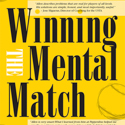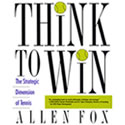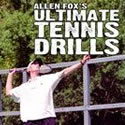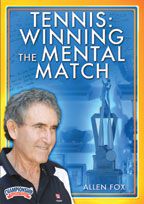REVIEW OF “THE GREATEST TENNIS MATCHES OF ALL TIME” BY STEVE FLINK
By Allen Fox, Ph.D. c 2013, all rights reserved
There have been so many great players and great matches in the past that we will, regrettably, never be able to see. Yes, the more recent ones like Nadal vs Federer and Williams vs Sharapova are on video tape, but what about the classic contests between Budge and Van Cramm, Vines and Perry, Lenglen and Wills, Gonzales and Hoad, etc.? Steve Flink brings them all to life in his wonderful new book, “The Greatest Matches of All Time.”
In it he gives you a point by point account of each match, along with the backgrounds of the players, their strengths and weaknesses, the importance and build-up to the match, and the careers and lives of the players afterwards. In many ways, it’s better than having been there! And only a tennis genius like Steve Flink can present the exacting detail in such a way that you can actually see and feel the physical and emotional struggles that took place on court so many years ago.
I love this book!! I keep it by my bedside and have already read it twice. Whenever I wish I can open it anywhere and get a relaxing, good read. It is so rich in detail that each perusal nets me a few gems that I missed the first time through. I don’t know how Steve did it. I have loved the game since childhood and read everything I could get my hands on about the greats of yesteryear, but never in this depth. I have always admired Steve for his historical knowledge of the game, but he must have done an extraordinary amount of additional painstaking research to produce a book of this quality. Moreover, you can comfortably believe in the accuracy of what you read. Steve Flink is an honest, understated gentleman. He doesn’t fluff, puff, or exaggerate, so you know when he says it, it’s indeed so.
Consider, for example, Steve’s depiction of the classic Arthur Ashe-Jimmy Connors clash in the 1975 Wimbledon final. He starts with a description of Arthur’s background – an African American brought up in Richmond by his widowed father, a policeman and stern disciplinarian. He was taught to be scrupulously honest with his calls, dignified, emotionally controlled, thoughtful of others, and to develop his mental skills with the same rigor he used with his physical ones. Arthur earned a scholarship at UCLA, where he distinguished himself as an excellent student and NCAA singles champion.
Arthur was a free-swinging, serve-volleying, shot-maker – unpredictable, creative, erratic, and, at the time of the match, 31 years old and somewhat of an underachiever. Yes, he had won the US Open in 1968 and the Australian two years later, but over the years his interest in international social issues had absorbed too much of his mental energy so that his results were spotty. Arthur was a classy, generous, decent person. (I can testify to this myself because I was a grad student at UCLA during his tenure there, and I knew him very well. The many reverent accounts written about his unselfishness and extraordinarily high moral character, were, believe it or not, understatements if anything.) Now, slightly over the hill, he was given little chance of defeating Connors, the brash, young defending champion whose game was at its peak.
Jimmy was brought up in Belleville, Illinois, and taught tennis by his mother, Gloria, and his grandmother, whom he called “Two Mom.” The two women taught him flat, mechanically-sound groundstrokes and a deadly two-handed backhand. He was a natural street-fighter – single-minded, antagonistic, churlish and disrespectful. He had one primary goal in life, and that was to win tennis matches, and he would stop at nothing to do so. The year before (1974) he had dominated the game as few others ever had, winning three of the four majors and 99 of 103 matches! He was a rough boy and the obvious favorite.
The contrast between the players’ games, personalities, on court behaviors, and off court activities was dramatic. While Arthur spent his time doing benevolent deeds and trying to make the world a better place, young Jimmy spent it fighting. Arthur was so respected by the rest of the players that he was, by 1974, President of the ATP, while in the same year Jimmy sued the ATP and Arthur Ashe personally as its President for $10 million on a scheduling and contract dispute. The showdown between these totally disparate characters took place the next year in the Wimbledon final. A fiction writer couldn’t have dreamed up a better script. (To be fair, I should add that Connors wasn’t really a bad guy. He was just young, brash, and rough around the edges. Seventeen years later he had transformed himself into a beloved old warrior and crowd favorite, reaching the US Open semi-final.)
I won’t repeat Flink’s blow by blow analysis of the match itself, other than to note that Ashe cunningly changed his normal slam-bang, frontal assault game to one of slices, changes of pace, wide serves, and minimal errors, knowing that Connors was quite good at countering flat serves and direct power. This also enabled Arthur to take advantage of one of Connors’ few weaknesses, his forehand approach shot played off of short, low balls. Arthur made sure to feed Jimmy plenty of these. As a result, Jimmy did not play his best, and though he struggled mightily to win anyway, as he always did, Arthur prevailed in four sets.
The epilogue to the match was that Arthur lost his reputation for being a talented underachiever and gained world-wide recognition for being a remarkable big match player and worthy addition to the lists of tennis greats. He continued to compete at the highest levels, but he was aging and never won another Grand Slam event. But he used his celebrity to help pursue his outside interests in international politics and charitable causes. He continued to compete into the late 1970’s, when he was felled with his first heart attack that ended his tennis career. Four years later he suffered a second attack. In 1988, at the age of forty five, Arthur began to lose motor function in his right hand and during the course of brain surgery, it was discovered that he had AIDS, contracted as a result of an earlier blood transfusion. Arthur went public with this information and for the remainder of his life became a spokesman for AIDS research in addition to his other compassionate causes.
As a person, he never changed. Arthur was the same soft-spoken, friendly, kindly human being as a world-renowned celebrity that he was as a teen-aged UCLA student. Tragically, he died at the age of 49, leaving behind his wife, Jeannie and his six-year old daughter, Camera.
Connors’ career slipped slightly afterward, and he was never again the totally dominant player he had been in 1974. Although later in 1975 he lost the US Open final to Spanish clay-court specialist, Manuel Orantes, (when the tournament was played on clay), he came back to win it in 1976 (on clay) and again in 1978 (on concrete). His first US Open win in 1974 had been on grass, so his latter two wins made him the only player to win the tournament on three different surfaces. He remained a top contender into the 1980’s and had a resurgence in 1982 and 1983 when he won two US Open titles (both over Ivan Lendl) and a second Wimbledon.
Of course Steve Flink says all of this in greater depth and far more eruditely than I have, but you get the idea. So if you want to immerse yourself in the history of tennis, his wonderful book is a thorough and enjoyable way to do it.
Steve Flink’s book is available on Amazon. Click here: http://www.amazon.com/The-Greatest-Tennis-Matches-Time/dp/0942257936
Notice: link_pages is deprecated since version 2.1.0! Use wp_link_pages() instead. in /home3/allenfox/public_html/allenfoxtennis/wp-includes/functions.php on line 3896
If you enjoyed this post, please consider to leave a comment or subscribe to the feed and get future articles delivered to your feed reader.
Warning: compact(): Undefined variable $limits in /home3/allenfox/public_html/allenfoxtennis/wp-includes/class-wp-comment-query.php on line 853
Warning: compact(): Undefined variable $groupby in /home3/allenfox/public_html/allenfoxtennis/wp-includes/class-wp-comment-query.php on line 853






